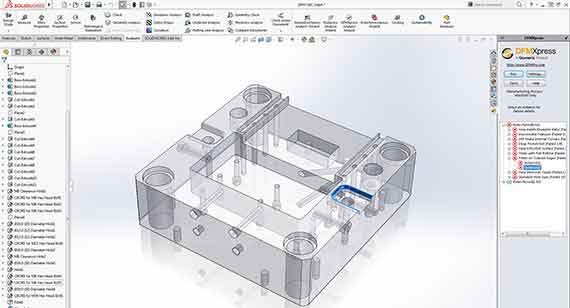Design Validation with SOLIDWORKS: CNC Machining
In part one of our three-part blog series, we looked at the rules of design for manufacturing (DFM) for the injection molding process. Specifically, what validation checks can you run in SOLIDWORKS before you send our design off for manufacturing? This one looks at CNC machining and how SOLIDWORKS can help to speed up your overall design process.
When it comes to CNC milling, it seems like it should be fairly simple to identify any features that cannot be machined. The process of starting with a block of material and cutting away sections from the outside working in should be straightforward. Inevitably though there is more to it than that. Deep holes with a small diameter are very difficult to achieve since the tool to create them would be very prone to breaking. Sharp internal corners are also a challenge as most cutting tools are round.

Analyze Manufacturability with DFMXpress
As machined parts get more complex, they are not always that easy to check visually. Handily, with SOLIDWORKS, you have DFMXpress. This is on the tools drop-down menu under Xpress Products and also in the Evaluate tab on the CommandManager. This can check your design’s suitability for multiple manufacturing processes including Mill/Drill, Turning with Mill Drill, Sheet Metal and Injection Molding.
Out of the box, DFMXpress is set up with industry-recommended values but it is completely customizable based on what you can achieve in-house or with your manufacturer. For Mill/Drill, DFMXpress will run 10 checks for manufacturability:
- It checks the hole-depth-to-diameter ratios of all the holes in the part.
- It looks for inaccessible features that could not be reached by the milling cutter.
- It identifies sharp internal corners, deep pockets and slots, holes with flat bottoms, fillets/rounds on outside edges.
- It looks for holes that are not standard sizes and if any holes or cutouts go all the way through the part, which could damage the CNC mill’s bed or require a second setup to cut from the other side as well.
Every check your design fails will be categorized, and each fail is listed individually, and clicking on each one highlights where it is in the part.
At any stage you can modify the part design and re-run the DFMXpress checks. The fewer failed checks, the easier and therefore usually cheaper the design will be to produce. If you want to understand the milling or turning process even better, you could start to set up and simulate toolpaths using SOLIDWORKS CAM.
Stay tuned next week for our final look at how you can leverage SOLIDWORKS to improve manufacturability on 3D-printed parts.
About the Author
Mark Rushton is a product portfolio manager for SOLIDWORKS, in the Desktop products team, focused on additive manufacturing. He has been involved with 3D CAD and 3D printing for over 15 years in several capacities from research to consulting for the likes of Rolls Royce, GE, JCB, and Dyson.